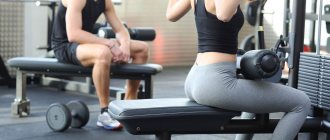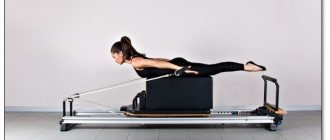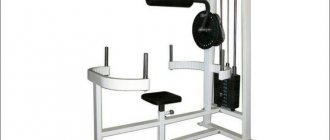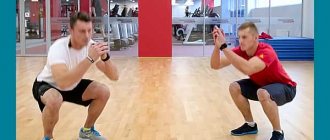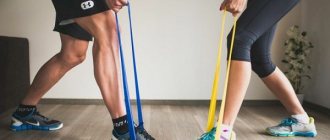Strength and mass training program in the gym. Find out how heavy strength training can help you gain muscle mass faster.
Strength and mass training program in the gym
Many people who have been training in the gym for several years do not get stronger. Many of them can barely bench press 100 kilograms, and even in Smith. Or do half-range squats with the same weight. They don’t really like deadlifts and military presses at all. They build their workouts according to articles from bodybuilding magazines: a bunch of isolated exercises, a huge number of approaches and repetitions. This gives negligible results. Then strength training comes to the rescue.
Today we'll look at how strength training works, how it differs from traditional muscle-building workouts, and look at the most popular training programs.
Benefits of Strength Training
When trying to gain muscle mass, many novice athletes make the same mistake - they avoid strength training.
An approximate chest workout for beginners looks like this:
- Smith press lying on a horizontal bench - 4-5 sets of 10-12 repetitions;
- Dumbbell press on a horizontal bench – 4–5 sets of 10–12 repetitions;
- Incline barbell press – 4-5 sets of 10-12 reps in a super set with push-ups (to failure);
- Dumbbell flyes lying on a horizontal bench - 2-3 drop sets to failure.
Useful article: “How to pump up the upper pectoral muscles? Exercises and training"
They train in this style every day for 1.5–2 hours, not realizing that such high-repetition work until a burning sensation is not suitable for amateur athletes. Instead, spend less time in the gym, lift heavier weights, and do fewer exercises.
Beginners think that strength training does not help in gaining muscle mass. This is a huge misconception.
Work with dumbbells
Strength exercises with dumbbells for men are an excellent option for both home exercises and gyms.
In addition to the dumbbells themselves, you need a bench. Stand sideways on a bench, place one leg and arm on it. Bend your back so that your body is parallel to your lower base. Bend your knees slightly.
Take a dumbbell in your other hand. The arm should be completely straight. Lift the projectile as high as possible, but do not lift by turning the body.
Having reached the top position, hold for a couple of seconds and then return to the original position. This training well develops the trapezius, latissimus and rhomboid muscles.
Strength training and muscle gain
There are three main ways to stimulate muscle tissue growth:
- Progression of loads;
- Muscle damage;
- Fatigue of muscle cells.
The most important of this is the progression of loads. The easiest way to do this is to constantly increase the working weights.
As a result of this, the muscles receive microtraumas - microscopic cell damage that occurs under heavy load. The body needs to be “repaired” after these microtraumas; this requires proper nutrition and rest. Then the muscles will recover, and the muscle cells will be able to cope with the subsequent load.
Fatigue of muscle cells occurs due to intracellular and extracellular changes that occur because the muscles are constantly contracting. When you push yourself to the limit and reach muscle failure, the muscle cells become fatigued.
Working with heavy weights and low repetitions increases strength and causes severe muscle damage. Lighter work with higher reps means more time under tension but causes less muscle damage.
Many will disagree with this, believing that pumping not only grows muscles, but also increases strength. This is wrong. But what's surprising is that strength work is also great for gaining muscle mass.
If you want to reach your full genetic potential, you need to do more strength training and less bodybuilding style training.
Many people do not understand this and cite the example of famous fitness models with chic shapes who do hundreds of repetitions in training. But you need to understand that when using anabolic steroids, the process of gaining muscle mass becomes easier than ever: you just pump and grow. In this case, it is advisable to work in a large repetition range. With high testosterone levels, muscles grow faster, but joints and ligaments cannot keep up with them. Because of this, injuries often occur.
If an amateur athlete trains in the same style as those using pharmacology: high volume, high number of repetitions, drop sets, super sets, etc., there will be practically no results. You will fatigue the muscle cells, but this is a weaker stimulus for growth than progressive loads. The results will be very slow.
Often in bodybuilding training, isolated exercises prevail over basic ones. This way, progress will be even less, since muscle mass gain is also influenced by the number of muscle cells under load.
Get strong to get muscular. There is no way without this. However, this does not mean that an amateur athlete cannot work in a high repetition range. High repetitions are suitable for experienced athletes, but they will never replace strength work.
Working with a rubber band
There are various exercises with a power band for men, focused on the development of certain muscle groups:
Arm bending. Firmly grasp the edges of the tape. If you work at home, you can fix the tape with your feet. Stand up straight, press your elbows to your torso. As you exhale, bend your arms at the elbow joints, leaving them pressed to your body. It is necessary to bring your hands to your shoulders. As you exhale, slowly straighten your arms.
Twisting the body. Position yourself at some distance from the elastic band. The distance should be such that when holding the edges you can feel a significant tension on the projectile and a press force. Lie on your back.
As you exhale, curl your abdominal muscles until your knees touch your chest. The back should be round. While inhaling, do not straighten your back, gradually lower yourself to the floor.
Squats. Take the ends of the elastic band in your hands, step on its middle part, placing your feet shoulder-width apart, spread your toes to the sides. Pull the band across your back as if you were putting on a backpack. While inhaling, gradually squat down.
The pelvic region should lower to the level of the knees, and the thigh should stand parallel to the floor. The knees should form a right angle, and their direction coincides with the toes.
Exhaling, using the muscles of the buttocks, pushing off with your heels, rise to the starting position. Lifting should be done a little faster than lowering.
The Best Strength Training Programs for Beginners
If you're used to high-rep, high-rep volume training, switching to strength-based circuits can feel overwhelming at first.
You'll be benching, pulling, and squatting some really serious weights. Depending on what training program you follow, you will train some parts of your body less often and others more often. Overall, you will be less tired from your workouts. You will rest much longer between sets. Training will take less time.
Don't be surprised if, after switching to a strength training program, you find yourself wanting to do more exercises, rest less between sets, or train more often. Don't make this mistake. You don't yet realize how quickly you can fall into overtraining if you do too much strength work.
Remember that your goal during strength training is to get stronger, not to burn as many calories as possible or to pound out your muscles.
If you don't have much experience in the gym yet, we recommend sticking to one of these programs.
Sports nutrition to increase strength
There are no specialized, magical supplements to increase strength. Except, of course, anabolic steroids (for example, Anadrol), which, if used incorrectly, can simply destroy health and the athlete will end his career.
Therefore, if you are not a professional athlete who is not threatened by the sport of the highest achievements, where people earn a lot of money and find sponsors, forget about steroids, concentrate your attention on sports nutrition, which, if used correctly, can significantly increase the strength of an athlete.
It is important to understand that the supplement itself is useless; it is necessary to use it in combination with strength exercises, then the muscles will respond to the load, increasing strength.
Creatine
The most important supplement for increasing strength is creatine (a nitrogen-containing carboxylic acid), which plays a huge role in energy metabolism when it comes to anaerobic training.
Accumulating mainly in the muscles, creatine accumulates energy, firing high levels of explosive power in competitions or training.
If there is a lack of creatine in the body, the athlete's strength will inevitably decline. Therefore, if you regularly work out in the gym and are looking to increase strength, creatine-containing supplements should be #1 in your sports nutrition bag.
Taking creatine monohydrate
Scheme "5x5"
This training program was developed back in 1976, and it was originally centered around three exercises: the bench press, the squat, and the clean. She looked like this:
Monday (hard training):
- Barbell clean – 5x5;
- Bench press – 5x5, 1x10;
- Barbell squats – 5x5, 1x10.
Wednesday (easy workout):
- Barbell clean – 5x5;
- Incline barbell press – 5x5, 1x10;
- Barbell squats – 5x5.
Friday (medium workout):
- Barbell clean – 5x5;
- Bench press standing behind the head – 5x5, 1x10;
- Barbell squats – 5x5.
How to choose the right working weight in approaches?
For each exercise, you start with light weights and gradually increase it. During heavy training, we select the working weight as follows:
1st approach – 35% of the maximum result when working for 5 repetitions.
2nd approach – 70% of the maximum result when working for 5 repetitions.
3rd approach – 80% of the maximum result when working for 5 repetitions.
4th approach – 90% of the maximum result when working for 5 repetitions.
5th approach – 100% of the maximum result when working for 5 repetitions.
For light training, we select the working weight as follows:
1st approach – 25% of the maximum result when working for 5 repetitions.
2nd approach – 50% of the maximum result when working for 5 repetitions.
3rd approach – 55% of the maximum result when working for 5 repetitions.
4th approach – 65% of the maximum result when working for 5 repetitions.
5th approach – 70% of the maximum result when working for 5 repetitions.
A set in which you work for 10 repetitions is performed with a weight of 55% of the maximum result when working for 5 repetitions.
For a medium-heavy workout, we select the working weight as follows:
1st approach – 30% of the maximum result when working for 5 repetitions.
2nd approach – 55% of the maximum result when working for 5 repetitions.
3rd approach – 65% of the maximum result when working for 5 repetitions.
4th approach – 70% of the maximum result when working for 5 repetitions.
5th approach – 80% of the maximum result when working for 5 repetitions.
A set in which you work for 10 repetitions is performed with a weight of 65% of the maximum result when working for 5 repetitions.
Useful article: “If you want to gain weight and muscle mass quickly.”
How to increase working weight?
It is recommended to increase the working weight in each exercise by 2.5% per week. For example, if at the start of the program your working weight in the bench press is 100 kilograms (for 5 repetitions), then the weight should be selected as follows:
Week #1
Bench Press (Heavy Workout):
1st approach – 35 kg (35% of the maximum result for 5 repetitions).
2nd set – 70 kg (70% of the maximum result for 5 repetitions).
3rd set – 80 kg (80% of the maximum result for 5 repetitions).
4th approach – 90 kg (90% of the maximum result for 5 repetitions).
5th approach – 100 kg (100% of the maximum result for 5 repetitions).
A set where you work for 10 reps is performed with a weight of 80 kg (80% of the maximum result when working for 5 reps).
Week #2
This week you increase last week's results by 2.5%. Now your maximum weight for 5 repetitions is 102.5 kg.
1st approach – 35 kg (35% of the maximum result for 5 repetitions).
2nd set – 70 kg (70% of the maximum result for 5 repetitions).
3rd set – 85 kg (80% of the maximum result for 5 repetitions).
4th set – 92.5 kg (90% of the maximum result for 5 repetitions).
5th approach – 102.5 kg (100% of the maximum result for 5 repetitions).
Because you increase the maximum weight quite a bit, the weight does not change in the first and second sets. In the third week, increase the working weight by another 2.5% and continue in the same spirit.
Rest time between sets
Rest 2-5 minutes between sets.
What to do if there is no progress?
If you can't complete the set number of repetitions, you need to take a step back. Work with the same weight you worked with 4 weeks ago.
Squats
The best strength exercises for men involve working with a barbell. It is better to do this in the gym, but you can place the apparatus at home.
This exercise allows you to pump up the front of your thighs and buttocks, using both legs. The abs and lower back are also pumped.
Additional weight can be used to increase the load. The latter is usually a barbell.
The projectile is located slightly above the shoulders. The last thing you need to do is rest against the bar from below and grab the bar. The brushes should be located almost at the pancakes themselves. Straighten up and gradually squat down. The back should be straight.
Take your time, work smoothly so that the load is evenly distributed and the muscles are fully involved.
Scheme “Stronglifts 5×5”
This is a simplified version of the classic 5x5 pattern. It is simple, effective and does not require long periods of time in the gym. This program includes two workouts in total.
Workout "A":
- Barbell squats – 5x5;
- Bench press – 5x5;
- Bent-over barbell row – 1x5.
Workout "B":
- Barbell squats – 5x5;
- Standing barbell press – 5x5;
- Deadlift – 1x5.
Only 3 workouts per week. There should be at least one rest day between workouts. The training process is structured in the same way as in the “Starting Strength” program: in the first week we do workouts A, B and A, in the second - B, A and B.
How to properly warm up before training?
Start with two sets of 5 reps with an empty bar, whether you're doing squats, bench presses, or standing presses. Then add 10-20 kg and do 2-3 repetitions. Continue adding 10-20 kg at a time and doing 2-3 repetitions until you reach your working weight. Don't rest for long periods between warm-up sets to avoid stretching out your workout. For deadlifts and bent-over rows, do not do sets with an empty bar. Without discs, you will not be able to place the barbell on the floor; you will have to keep it in the air all the time.
Never start working on a 5x5 pattern without warming up. This will make the weight feel heavier than it actually is, you will do fewer reps, and you may get injured. Start with an empty bar so you get the hang of the technique.
Doing cardio before strength training will not be enough. This may work against you. Too much cardio before your workout will tire your legs and make it harder to squat with heavy weights.
How to increase working weight?
The principle of progression is simple: add 2.5 kilograms each time for each exercise. Yes, so in a week you will increase your squats by 7.5 kilograms. Beginners can do this quite well. For experienced athletes - impossible.
Rest time between sets
Rest 2-5 minutes between sets.
What to do if there is no progress?
If you can't complete the set number of repetitions, you need to take a step back.
COMMON CASE
During training, try not to deviate from the given trajectory, and do not switch to simulators and exercises that are not yet familiar to you. In small gyms, where the instructor plays the role of “supervisor” of the equipment so that the jocks don’t break anything and drag them home, the following picture is often encountered :
A beginner comes, opens his notebook and begins to do the exercises he found on the Internet in order. After completion, check the “done” box. He approaches the next machine on the list and sees that the machine is busy, the next one on the list is also busy, after which he grabs 2 heavy dumbbells of 16-18 kg each and begins to swing them in different directions, making a smart face. After 10-15 minutes of swinging, he kills his arm muscles, gets tired, forgets about the uncompleted exercises and heads towards the exit. And he does this for several months in a row.
After six months of diligent, in his opinion, training, he strips naked, stands in front of the mirror and... does not see the results he dreamed of. The newcomer finally decides to familiarize himself with human anatomy and dives headlong into the Internet. And imagine his surprise when it begins to dawn on him that his dumbbell swings work the same arm muscles that he works with on the butterfly machine. Meanwhile, his other muscle groups remained completely undeveloped.
To avoid such mistakes, it is recommended to at least superficially study the structure of the human body, as well as all the exercise equipment that is in the gym.
Initially, you need to know what muscles you want to pump , and what machines or exercises can help you with this.
Texas method
This is a common training scheme among intermediate and advanced athletes.
Like other strength programs, the Texas Method only performs 3 workouts per week. On Mondays, volume training, on Wednesdays – light, on Fridays – very hard (we work with maximum weight).
Week "A"
Monday (volume training):
- Barbell squats – 5x5 (with a weight of 90% of the maximum for 5 reps).
- Bench press - 5x5 (with a weight of 90% of the maximum for 5 repetitions).
- Deadlift - 1x5 (with a weight of 90% of the maximum for 5 reps).
Wednesday (easy workout):
- Barbell squats - 2x5 (with a weight of 70% of the maximum for 5 repetitions).
- Bench press standing behind the head - 3x5 (with a weight of 70% of the maximum for 5 repetitions).
- Reverse grip pull-ups – 3 sets to failure with your own weight.
- Hyperextension – 5x10.
Friday (hard training):
- Barbell squats – 1x5 (with maximum weight).
- Bench press – 1x5 (with maximum weight).
- Deadlift – 1x5 (with maximum weight).
Week "B"
Monday (volume training):
- Barbell squats – 5x5 (with a weight of 90% of the maximum for 5 reps).
- Standing barbell press – 5x5 (with a weight of 90% of the maximum for 5 repetitions).
- Deadlift – 1x5 (with a weight of 90% of the maximum for 5 reps).
Wednesday (easy workout):
- Barbell squats – 2x5 (with a weight of 70% of the maximum for 5 repetitions).
- Bench press – 3x5 (with a weight of 70% of the maximum for 5 repetitions).
- Reverse grip pull-ups – 3 sets to failure with your own weight.
- Hyperextension – 5x10.
Friday (hard training):
- Barbell squats – 1x5 (with maximum weight).
- Standing barbell press – 1x5 (with maximum weight).
- Deadlift – 1x5 (with maximum weight).
Useful article: “Gaining muscle mass for beginners: nutrition, training, supplements.”
Alternate weeks A and B to progress in both the bench press and standing press. Volume and light workouts are built on a simple principle: you just warm up and do the planned approaches. On Fridays, work with maximum weights. Each exercise starts with warm-up sets and then you do a heavy set of 5 reps. Each time the weight should be increased by 2.5–5 kilograms.
How to properly warm up before training?
The first warm-up approach is done with an empty bar, then the weight is gradually increased. For example, if you are squatting a 250-pound barbell, your warm-up should look something like this:
- Empty bar (20 kg) – 2x5;
- 60 kg – 2x5;
- 85 kg – 1x3;
- 105 kg – 1x2;
- 125 kg (working weight) – 3x5.
How to increase working weight?
The goal of the Texas Method is to increase your lifting weights weekly. So we add 2.5 kilograms every Friday when we do heavy sets with maximum weights for 5 reps. Because of this, every Monday and Wednesday you will start from a new number.
Rest time between sets
Rest 2-5 minutes between sets.
What to do if there is no progress?
If you cannot cope with the volume planned for Monday, you need to reduce the volume of work from 5 to 3 approaches or reduce the weight by 10% of the maximum. Focus more on recovery to prevent this from happening.
If you can handle your volume training on Monday but can't hit the new weight on Friday, then you need to increase your training volume and intensity on Mondays. For example, instead of doing 5 sets of 5 reps with a weight of 90% of your maximum, do 5 sets of 8 reps with a weight of 80% of your maximum.
Flexion and extension of the torso
For this training you will need a bench. If you train at home, you can build a simple structure yourself or even just arrange chairs in a row.
Lie on the bench on your stomach. Allow your upper body to hang and your heels to rest behind you. Place your hands behind your head and lift your torso so that your head rises above the level of your buttocks.
There is no need to do excessively high lifts. This is fraught with activation of the thigh muscles, which will reduce the effectiveness of the training.
Scheme "5/3/1"
The “5/3/1” training program is one of the most common because it is intuitive, does not require specific equipment, and the workouts are quite short. And most importantly, it brings the desired results.
In total there are 3-4 workouts per week:
- Barbell squats and assistance work;
- Bench press and accessory work;
- Deadlift and assistance work;
- Standing press and auxiliary work.
Each microcycle of training according to the “5/3/1” system of four conditional “waves”.
After completing all stages, everything starts all over again. The microcycle is built as follows:
Wave No. 1
| Approach number | % of 90% of the one-time maximum | Number of repetitions |
| 1 | 65% | 5 |
| 2 | 75% | 5 |
| 3 | 85% | 5+ |
Wave No. 2
| Approach number | % of 90% of the one-time maximum | Number of repetitions |
| 1 | 70% | 3 |
| 2 | 80% | 3 |
| 3 | 90% | 3+ |
Wave No. 3
| Approach number | % of 90% of the one-time maximum | Number of repetitions |
| 1 | 75% | 5 |
| 2 | 85% | 3 |
| 3 | 95% | 1+ |
Wave No. 4
| Approach number | % of 90% of the one-time maximum | Number of repetitions |
| 1 | 40% | 5 |
| 2 | 50% | 5 |
| 3 | 60% | 5 |
Initially, the 5/3/1 program calculates 90% of your one-time maximum, and not of your 5-rep maximum, as in other strength programs. In approaches where “+” is indicated in the number of repetitions, you need to do as many repetitions as possible. Each workout consists of a warm-up and three hard working sets. Due to such a small amount of work, the 5/3/1 program is subject to a huge stream of criticism. But this does not change the fact that it works.
It won't suit everyone. If you have several years of strength training in the gym under your belt, 5/3/1 is not the best choice. However, beginners can achieve serious results using this approach. Especially if you include “auxiliary” work in the program (more on that later). This way you will create a combined training style, combining strength training and work on the “beach” muscles.
Depending on how often you train, the program will vary. If you train 4 times a week, each microcycle will last 4 weeks. If 3 times – 5 weeks and 1 day. For four workouts per week, the program looks like this:
Week #1
| Workout number | Exercises | "Wave" |
| 1 | Standing press | 1 |
| 2 | Deadlift | 1 |
| 3 | Bench press | 1 |
| 4 | Squats | 1 |
Week #2
| Workout number | Exercises | "Wave" |
| 1 | Standing press | 2 |
| 2 | Deadlift | 2 |
| 3 | Bench press | 2 |
| 4 | Squats | 2 |
Week #3
| Workout number | Exercises | "Wave" |
| 1 | Standing press | 3 |
| 2 | Deadlift | 3 |
| 3 | Bench press | 3 |
| 4 | Squats | 3 |
Week #4
| Workout number | Exercises | "Wave" |
| 1 | Standing press | 4 |
| 2 | Deadlift | 4 |
| 3 | Bench press | 4 |
| 4 | Squats | 4 |
If you train 3 times a week, the whole process will take 5 weeks and 1 day, which is how long it will take to complete all 16 workouts.
Week #1
| Workout number | Exercises | "Wave" |
| 1 | Squats | 1 |
| 2 | Bench press | 1 |
| 3 | Deadlift | 1 |
Week #2
| Workout number | Exercises | "Wave" |
| 1 | Standing press | 1 |
| 2 | Squats | 2 |
| 3 | Bench press | 2 |
Week #3
| Workout number | Exercises | "Wave" |
| 1 | Deadlift | 2 |
| 2 | Standing press | 2 |
| 3 | Squats | 3 |
Week #4
| Workout number | Exercises | "Wave" |
| 1 | Bench press | 3 |
| 2 | Deadlift | 3 |
| 3 | Standing press | 3 |
Week #5
| Workout number | Exercises | "Wave" |
| 1 | Squats | 4 |
| 2 | Bench press | 4 |
| 3 | Deadlift | 4 |
Week #6
| Workout number | Exercises | "Wave" |
| 1 | Standing press | 4 |
| 2 | — | Rest |
| 3 | — | Rest |
How to properly warm up before training?
1st approach – 40% of the one-time maximum for 5 repetitions;
2nd approach – 50% of the one-time maximum for 5 repetitions;
3rd approach – 60% of the one-time maximum for 3 repetitions.
Between warm-up sets we rest for 60–90 seconds.
How to increase working weight?
Your goal is not just to increase your one-time maximum, but to make continuous progress after each microcycle. When you have completed one microcycle, increase the maximum weight on the bench press and standing press by 2.5 kilograms, and on the squat and deadlift by 5 kilograms. Calculate further weights based on the current result. If you feel that in the last, heaviest sets, you still have the strength for a few repetitions, do them.
Rest time between sets
Rest 2-5 minutes between sets.
What to do if there is no progress?
If you have stagnation or even regression, complete your microcycle, and then reduce the one-time maximum from which you start by 10% and start over. This should be done only in those exercises in which the result does not increase. Do the rest as usual.
Deadlift
The list of strength exercises in the gym for men, as a rule, always includes deadlifts. But, if desired, it can be done at home.
However, due to the complexity of the procedure, it is better to perform it in the presence of a trainer. It is important to observe a lot of nuances here, since there is a high risk of injury.
The feet should be placed parallel to each other. Bend your knees slightly and keep your back straight at all times. Raise your head so that your gaze is oriented upward.
The projectile must be taken in the standard way. The distance between the hands should slightly exceed the width of the shoulders. Stand up straight, straighten your legs, and move your shoulders back a little.
What kind of support work needs to be done?
By auxiliary work we mean exercises that you do in addition to the main four. Only you can decide how much utility room you need. This is done for the following reasons:
- To make stronger those muscles that “fall out”;
- To increase your results in the four main exercises;
- So that the muscles develop in a balanced and symmetrical manner;
- To gain more muscle mass.
The following exercises are best suited to complement the base:
- Dips (preferably with additional weights);
- Pull-ups with direct and reverse grip;
- Bent-over dumbbell row;
- Bent-over barbell row;
- Shrugs with a barbell;
- Dumbbell bench press;
- Seated dumbbell press;
- Lunges;
- Leg press.
The author of the program calls the auxiliary work boring, but effective. He believes that it is optimal to do heavy sets of the basic exercises from the program, then do 5 sets of the same exercise for 10 repetitions, and then do 5 sets of the accessory exercise for 10 repetitions.
For example, a squat workout might look like this:
- Squats are the main working approaches;
- Squats – 5x10;
- Lunges – 5x10.
To work for 10 repetitions, it is recommended to start with a weight of 40-50% of the current one-time maximum and gradually increase it.
How much weight you use is up to you, but it is not recommended to use a weight that is too light and that you can squat more than 10 times with.
Features of strength training
You already know what muscles are and how to properly train them for growth. We discussed this in the last post, and now we will move further along the path of creating a new version of ourselves and our body.
Almost all athletes (sometimes even chess players) resort to strength training. To avoid stagnation in progress, bodybuilding enthusiasts alternate training for mass and strength. With this training option, your muscles will respond to exercise much better.
Powerlifters have been following strength training programs for years to improve their strength lifting performance. For martial arts fans, such training is simply irreplaceable, because here they increase their strength qualities with minimal increases in their own weight.
Strength training puts serious stress on the body, so when creating a training program, it is necessary to take into account the rest between workouts. Training programs for strength development are scheduled mainly for three days a week. This distribution of loads allows your body to rest properly.
In addition to rest between workouts, the following features should be taken into account:
- A training program in the classic version should, as a rule, consist of basic exercises. Basic exercises - the most difficult 70-80% of training time should be devoted to the basics.
- Maximum weights will help you. Don’t give yourself any concessions, the one-time maximum is your working weight during training.
- Work your ass off. In working approaches, exercises should be performed with all your might.
- Avoid cheating. Exercises must be performed with good technique. There is no need to mess around and help yourself by swaying like the Ostankino tower in the wind, work only with the desired muscle group.
- More sets, fewer reps per set. To develop strength, the maximum number of repetitions in a set should not exceed five. If you were able to do more, it means you cheated and took too light a weight.
- Long rest between sets (at least three minutes). Each set puts a lot of stress on your body. Before the next approach, a mandatory rest of about three minutes for recovery. As soon as you feel completely rested, start the exercise.
- When creating a training plan, do not include more than two muscle groups in 1 day. Here we mean only the necessary muscle groups. As a cool-down, you can add pumping of small muscle groups, within reason, of course.
- Get a gym partner. You need someone to insure you, otherwise you won't be able to perform at your best.
Don't be upset when you see the rules here too. You remember: a competent attitude means faster progress.

